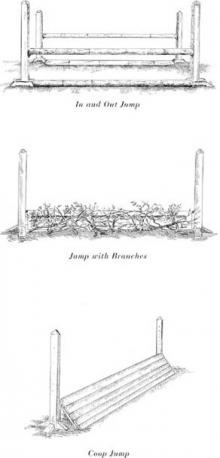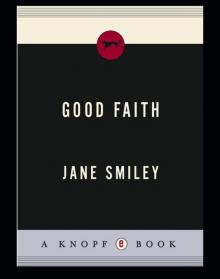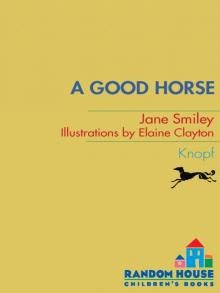- Home
- Jane Smiley
Charles Dickens Page 7
Charles Dickens Read online
Page 7
Upon his return to Genoa, Dickens took up mesmerism. An Englishwoman, Madame de la Rue, had several long-standing complaints that Freud might have called hysterical and we might call schizophrenic. Dickens successfully hypnotized her over and over; during these sessions, he elicited background material and gave her instructions. The progress of her condition was in some ways alarming, but Dickens’s confidence in his “treatment” never flagged, and he persisted, ultimately affording her considerable lasting relief from the conviction that she was being visited at night by a phantom. For Dickens, of course, this “relationship” had irresistible fascination. For one thing, he became intimate to an unusual degree with just the sort of mental pathology and extreme idiosyncrasy that he always found interesting, and for another, his “treatment” was working, which he admitted gave him a sense of power. For a third, the relationship was with a woman, therefore it could be intimate and platonic at the same time. We can only marvel at how, once again, something that turned up in Dickens’s life, like his American celebrity, uncannily presaged a common feature of our time—the therapeutic relationship. That Dickens should prefigure Freud makes wonderful sense, since Freud loved Dickens and since both Freud and Dickens were essentially highly observant storytellers who gave large meanings to very small details and actions, creating worlds of interlocking meaning out of, in particular, repetition, unconscious actions, and habitual interactions. But Dickens’s pleasure and interest in his “treatment” of Madame de la Rue aroused a protest from Catherine, perhaps her first ever, and even though he was nettled by her reaction, he cooled the relationship. As with acting, perhaps, “therapy” was a great talent Dickens could have developed if circumstances had fallen differently.
While not exactly giving up his desire to live abroad, Dickens returned to England periodically and involved himself in yet another aborted scheme that redounded less well to his reputation, the founding of a daily newspaper. Dickens’s new publishers, Bradbury and Evans, thought it a good time to start a newspaper to rival the Times and the Morning Herald, but with radical sympathies. Much of the money was railroad money, and the railroad was the transforming technological news of the day. Controversy surrounding The Chimes had proved both profitable and enlivening; how better to build upon it than to make the famous Charles Dickens editor of a paper that would institutionalize his liberal views? Dickens was equally enthusiastic and entered with fervor into the planning of the first editions. He hired the staff (including his father, John Dickens, as manager of the parliamentary reporters). There was a setback—one of the money men went bankrupt. Dickens resigned. But the investors reorganized and found more money, and the project went forward again.
In the meantime, Dickens wrote his third Christmas book, A Cricket on the Hearth, which had no social dimension at all but was the tale of a jealous elderly man and his young wife, perhaps, according to Ackroyd, a reworking of Dickens’s own marriage with the genders reversed. There are two important things about A Cricket on the Hearth. One of them is that work on the newspaper affected the time and attention Dickens was able to devote to his narrative. The other is that it was a commercial success, selling twice as many copies as The Chimes. That the Christmas books established ever more clearly Dickens’s direct relationship to his public was of great importance to him, and all the more important as the first issues of the Daily News began to take shape.
January 21, 1846, was the first day of publication, and it was not quite a success—there were typos and mistakes; Dickens was dissatisfied with his staff and his work arrangements. It quickly became clear that the project was not going to work as planned, and on February 9, Dickens resigned. In fact, his resignation was considered appropriate by most parties, since he was not exactly suited to the day-to-day detail work of an ambitious newspaper—there was too much of it, and he was constitutionally incapable of delegating editorial duties, as other experiences with weekly and monthly periodicals showed. Nevertheless, at first the transition seemed like a crisis—Dickens had formed the staff and the paper as much in his own image as possible, and there was some question about whether it could go on without him. But the crisis passed, and John Forster became the editor for about nine months. After that, the paper grew and established itself and continued to publish into the twentieth century. The contradictions in Dickens’s character—his impulsiveness, his energy, his resistance to being the least bit fettered, and his readiness to blame others—all emerged in this battle, and the partners complained both that he was not doing his job well and that he didn’t want to do it any longer. Clearly, however, editing a daily newspaper, while it appealed to the commercial, social, and political sides of Dickens’s character, did not appeal to his deeper need to make art.
Dickens decided to relocate to the Continent again, and this time he chose Lausanne, Switzerland. He and Catherine now had still another son, Alfred, born at the end of October 1845, the sixth child and fourth son. Dickens was thirty-four. In ten years, he had written six full-length novels and three novellas, not to mention any number of occasional pieces. He had fathered six children. He was still working with Angela Burdett-Coutts on charitable projects, most notably the home for reformed prostitutes, Urania Cottage. He was directing, producing, and performing in ambitious amateur plays (in 1845, Dickens and some friends did a production of Ben Jonson’s play Every Man in His Humour). His energy, sociability, and liveliness still struck everyone, including, now, his children, who recalled later how much fun he had been in their early childhoods, playing with them, chatting with them, charming them, attending to them with particular affectionate concentration that caused them to adore him in return.
Lausanne was clean, quiet, and pretty. Shortly after arriving there, at the end of June 1846, Dickens went back to his real work and began to write Dombey and Son. As with Martin Chuzzlewit, he had been planning the structure of Dombey and Son carefully and as a whole. He also, from the beginning, intended to introduce some autobiographical material and based the establishment of Paul’s “caretaker,” Mrs. Pipchin, on a woman he had stayed with as a boy. But Dombey is different from earlier novels in that the protagonist, the character to be transformed, is an already mature man who bears some resemblance to Scrooge rather than to the many youthful heroes of earlier works. This choice immediately gives the novel more structural coherence—Dombey is an established man with a household, a mode of life, a set of acquaintances, and a very particular agenda. It is his certainty and pride that form the world of the other characters.
Dombey and Son, like several other nineteenth-century works (Vanity Fair, for example, which was published at the same time, and A Doll’s House, and “The Death of Ivan Ilyich”) concerns the commodification of familial relationships. Dickens is explicit—of Dombey’s estimation of his daughter Florence, he writes in the first chapter, “But what was a girl to Dombey and Son! In the capital of the House’s name and dignity, such a child was merely a piece of base coin that couldn’t be invested—a bad boy—nothing more.” When Paul Dombey is born, as proud and pleased as his father is, the man gets no present enjoyment from his child but only anticipates their future business partnership. Impatient to get the necessary processes of childhood, like illnesses and education, out of the way, he hardly notices Paul’s actual circumstances—delicacy and ill health—and is astounded to be informed of them. Nor does he experience the affection of his favorite child, who is cared for by others and who rather shrinks in his father’s presence. He looks upon the love between Paul and Florence with jealous impotence. The sight moves him to envy, and to spite toward Florence, but not to any form of self-doubt or introspection. What is especially interesting about Dombey is that the origins of his pride and remoteness are not at all investigated. His identification as a wealthy merchant serves to explain why as well as what he is. It is this sense of Dombey’s character originating in his business life that differentiates him from Scrooge, for example, and makes Dombey and Son all the more pointed a critique of capitali
st relationships.
Dickens was pleased with the first numbers of Dombey and Son but found the going difficult. He attributed this to being away from London. He wrote Forster, “A day in London sets me up and starts me. But the toil and labor of writing, day after day, without that magic lantern, is IMMENSE!!” Nevertheless, theme, story, and, most important, style fell together seamlessly in the new novel. A great novel is, as much as anything else, an exercise of sustained stylistic felicity, and everyone—Dickens, Forster, other friends, the critics, and the public—recognized with the first number that Dickens had uncovered his sharpest, easiest, and most flexible voice. The first paragraphs draw us in effortlessly, wittily, and economically. The scene has a momentary stillness and intimacy, like a movie close-up. The father, sitting beside the fire, is connected to the newborn son, drawn up to the fire in his basket. Both are bald, red, and not quite beautiful; both are subject to the depredations of time. We are asked immediately to regard them not only as characters and agents of the story, but as objects of contemplation. The invitation is graceful, almost homely—the son is likened to a muffin; his just born appearance is “somewhat crushed and spotty in his general effect, as yet,” but out of the simplest of contrasts between the baby and the man, Dickens draws a beautifully evocative figure: “The countenance of Son was crossed and recrossed with a thousand little creases, which the same deceitful Time would take delight in smoothing out and wearing away with the flat part of his scythe, as a preparation of the surface for his deeper operations.”
Dickens’s tonal and stylistic choices were always remarkable for their richness and variety. He could do low comedy, melodrama, farce, fairy tale, confession, sarcasm, lyricism, romance, extended analogy, dialect imitation. He had an ear for every sort of discourse, both written and oral. He did not always use an elevated literary style, something for which he was criticized in his time. He was not always considered to be in control of his material, but rather he was sometimes accused of being carried away, into sentimentality or tastelessness. Certainly, in Martin Chuzzlewit, extended use of personification and figurative language to little apparent purpose had tried his audience. But the control he shows throughout the nine hundred pages of Dombey and Son is exceptional, especially for a novelist publishing in serial parts. Certain critics have pointed out that the characters of the novel are particularly “Dickensian”—that is, they show vivid, repetitive, almost mechanically unchanging behaviors. Only the most extreme challenges can wrench them out of the habitual modes of expression and behavior. In part because the novel is a kind of tableau vivant, this “Dickensian” effect works better here than in some of the other novels, but because the characters are very distinct, the author has to vary the tone and style of the narrative. The style of Dombey routinely accomplishes all of this. Chapter 29, for example, where Dombey’s sister informs Miss Tox of Dombey’s engagement to Edith, is a hilarious set piece, where the mutually exclusive viewpoints of the two women, the brother-in-law, the spying Major Bagstock, and Major Bagstock’s Eastern servant all clash and contrast, only to be briefly but gracefully resolved in the last paragraph, with the narrator’s own voice: “While poor excommunicated Miss Tox, who, if she were a fawner and a toad-eater, was at least an honest and a constant one, and had ever borne a faithful friendship towards her impeacher, and had been truly absorbed and swallowed up in devotion to the magnificence of Mr. Dombey—while poor excommunicated Miss Tox watered her plants with her tears, and felt that it was winter in Princess’s Place.”
Dickens’s characters in general have often been criticized for not being “realistic” or “rounded,” especially his women characters. Certainly they contrast with those of, say, George Eliot or Henry James. Whether this contrast arises from something lacking in Dickens or something present in Dickens that is not present in the others (comic exaggeration, for example), Dickens’s characters often seem weirdly truer to life than those of more realistic novelists. While some readers consider the oft-repeated calling cards of some characters evidence of one-dimensionality, in fact, it is a standard literary device to give minor comic characters taglines or bits of repeated business so that they can distinguish themselves. Additionally, such calling cards are features of romance as well as the literature of the spiritual journey, such as Pilgrim’s Progress, in which a rather colorless hero meets personifications of tests, challenges, or qualities that he needs to assimilate in order to achieve his goal. Dickens, with his many innocent heroes and heroines from Pickwick to Esther Summerson, clearly writes in these traditions. Furthermore, the novel as a genre is particularly capacious in terms of the confluence of theme and form. That it is written in prose seems to make it more naturally “realistic,” but in fact it may use the devices of any type of narrative. Dickens repeatedly pushed the English novel away from standard realism at the same time that he pushed it away from depicting the English bourgeoisie. He expanded the social/economic scope of the novel while expanding its linguistic resources with no regard for class status or stylistic propriety—he gave his narrator and his array of characters many tongues to speak in, quite a few of which were visionary or poetical, and which themselves undermined the “realism” of the form. Ultimately, he required, or allowed, the reader to regard more of the life around him by allowing it to be important enough to get into a novel. He thereby expanded the audience of the novel itself.
We may add to this by pointing out Dickens’s pivotal position in the shift in English literature from a countryside-based production to an urban-based production. Not only does Dickens’s work look back to Pilgrim’s Progress, it looks forward to Dostoevsky, Freud, and Kafka, three authors who were greatly influenced by Dickens. Many of Dickens’s characters seem diagnosable, at least as harmless neurotics, but sometimes as murderous psychotics or tormented obsessive-compulsives or manic-depressives. How they present themselves has the repetitive clarity of mental dysfunction translated into social dysfunction. In his comic mode, the characters manage to overcome the isolation attendant upon their individual dysfunctions and connect with one another. In his tragic mode, they do not, but instead suffer further isolation and death. The question is not whether Dickens’s characters are “realistic,” like those of Jane Austen, but whether he makes a compelling case for the origins and resolutions of their dilemmas, which are, in many cases, extreme and melodramatic. These are exactly the terms in which most people experience their own dilemmas—life-or-death propositions that are tremendously challenging to resolve. Kafka, for example, often wrote of his conflict with his father as if one or the other of them had to die. Freud depicted the suffering of “the Wolfman” and of “Dora” (named after David Copperfield’s first wife) in vivid terms, even though to the average reader their problems seem almost negligible. Dickens excelled at bodying forth the drama of the inner battle. Sometimes it is truly an inner battle, as in Scrooge or in Edith Dombey. Other times it seems to be a social or political battle, as in Barnaby Rudge or Oliver Twist, but the resolution always takes place within the character first and then in the social nexus. The difference between Dickens and Dostoevsky or Kafka has to do with the persistence of the social and political world. The very thing that Dickens worked against, and grew increasingly frustrated by in his social concerns—that is, the apparent resistance to change of English society—is what gives the world of his novels their reassuring comic stability. Conditions don’t change, but people can; so Dickens, his characters, and his readers are afforded some measure of relief while still protected from the sort of terrifying vertigo that is a feature of later European literature.
Charles Dickens was a secretive man. Acquaintances, friends, relatives, and children always commented upon the fact that he could withdraw as readily as he could extend himself, that while he was so eagerly observing others he was also resisting observation himself. In our own time we see that great celebrity creates secretiveness, because the natural middle ground of private life is so difficult of attainment for those who live in t
he eye of the media. Certainly, secretiveness as an aspect of celebrity operated intermittently in Dickens’s life—especially during his sojourn in America, where his fans were much more intrusive than his English ones. But the larger part of Dickens’s secretiveness had deeper origins and longer-lasting effects. The fact is that modern readers know more of Dickens’s early life than any of his contemporaries, including his wife and children, precisely because he made it his business to keep his family origins and his childhood to himself. There are several aspects to this. For one, Dickens did not come from a respectable family. His father, John Dickens, was persistently impecunious. Though he had many jobs and did well at them, he was not able to live within his income and had a habit of not only borrowing from his son, but also trying to make money by selling Dickens’s manuscripts and autographs behind his back or approaching Charles’s friends and asking for loans. Dickens’s mother, Elizabeth Barrow Dickens, was the daughter of Charles Barrow, who worked as a clerk at the Navy Pay Office. In 1810, the year John and Elizabeth’s first child, Fanny, was born, Charles Barrow was discovered to have embezzled several thousand pounds and escaped the country before he could be prosecuted. Most of Dickens’s antecedents came from the serving class rather than the professional or propertied classes. The routine and even required American process of leaving one’s origins behind was much more difficult in England, even in the England of Dickens’s time, which was undergoing a vast social shift. Dickens’s friends—Maclise, Macready, Wilkie Collins, and Forster himself—were usually men who, like Dickens, had used talent and energy to make their own way. But as they rose in economic and social status, they encountered more conservative elements of society, men and women who gave them respect for their accomplishments, but a respect always circumscribed by reservations about dress, or education, or behavior, or modes of speaking. Dickens’s colorful manner of dressing, for example, was always judged as a bit déclassé. The sheer weight of his talent and charm gained him passage pretty much wherever he wanted to go in English society, but it did not gain him the invisibility of perfect acceptance. One index of this was the difficulty his daughters had, later on, in making good marriages. For all these reasons, Dickens’s secretiveness and shame at his origins was a realistic response to the closed, judgmental nature of English social life.

 The Georges and the Jewels
The Georges and the Jewels Pie in the Sky: Book Four of the Horses of Oak Valley Ranch
Pie in the Sky: Book Four of the Horses of Oak Valley Ranch Duplicate Keys
Duplicate Keys Charles Dickens
Charles Dickens Good Faith
Good Faith Private Life
Private Life A Thousand Acres: A Novel
A Thousand Acres: A Novel The Greenlanders
The Greenlanders Ten Days in the Hills
Ten Days in the Hills Gee Whiz: Book Five of the Horses of Oak Valley Ranch
Gee Whiz: Book Five of the Horses of Oak Valley Ranch A Thousand Acres
A Thousand Acres The All-True Travels and Adventures of Lidie Newton
The All-True Travels and Adventures of Lidie Newton Ordinary Love and Good Will
Ordinary Love and Good Will Taking the Reins (An Ellen & Ned Book)
Taking the Reins (An Ellen & Ned Book) The Man Who Invented the Computer
The Man Who Invented the Computer Horse Heaven
Horse Heaven The Age of Grief
The Age of Grief Riding Lessons
Riding Lessons Perestroika in Paris
Perestroika in Paris A Good Horse: Book Two of the Horses of Oak Valley Ranch
A Good Horse: Book Two of the Horses of Oak Valley Ranch Saddles & Secrets (An Ellen & Ned Book)
Saddles & Secrets (An Ellen & Ned Book) Some Luck: A Novel
Some Luck: A Novel Champion Horse
Champion Horse Some Luck
Some Luck Gee Whiz
Gee Whiz Barn Blind
Barn Blind A Thousand Acres (1992 Pulitzer Prize)
A Thousand Acres (1992 Pulitzer Prize) Pie in the Sky
Pie in the Sky True Blue
True Blue A Thousand Acres_A Novel
A Thousand Acres_A Novel A Good Horse
A Good Horse